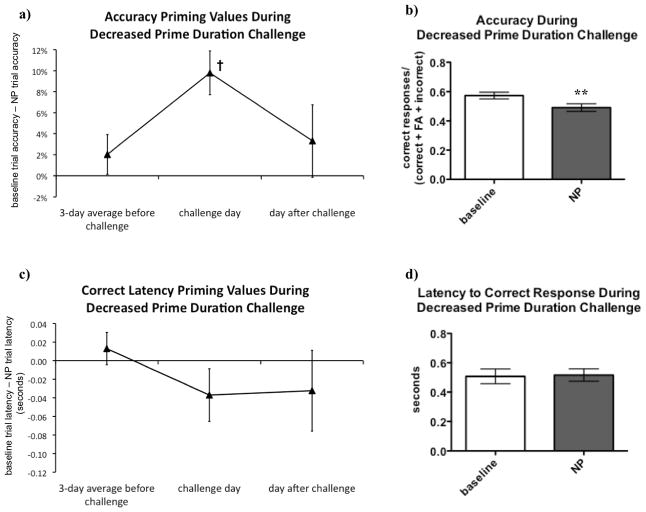Figure 5.
The effect of the decreased prime stimulus challenge to enhance negative priming (NP) was sustained upon repeated challenge. On the day of the second decreased prime duration challenge, accuracy priming values again became more positive, reflecting more NP (A), with a very strong trend towards differences between the accuracy priming values obtained before, during, and after the challenge [F(2, 24) = 3.40, p = 0.05]. Rats again exhibited significantly higher accuracy in baseline trials compared with NP trials [t(12) = 3.66, p < 0.01] on the day of the challenge (B). Although there was a tendency for correct latency priming values to become more negative on the day of the challenge, also reflecting more NP (C), this tendency persisted on the day after the challenge, and did not result in statistically significant differences in response latency priming values on the different days [F(2, 24) = 2.19, p > 0.1]. There was no significant difference between correct response latencies in baseline and NP trials [t(12) = 0.38, p > 0.1] on the day of the challenge (D).
Data were analyzed using repeated-measures analyses of variance (ANOVA) to compare the priming values during challenge to the sessions before and after the challenge. When statistically significant effects were found in the ANOVAs, post hoc comparisons among means were conducted using Newman-Keuls tests. Paired two-tailed t-tests were used to compare performance during baseline and NP trials on the duration challenge days. Values are expressed as mean ± SEM. Dagger symbol (†) denotes trend toward difference between with days before, during, and after the challenge; asterisks (**p < 0.01) denote significant differences compared with baseline trials.

